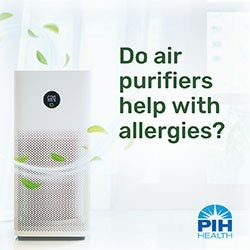Do Air Purifiers Help With Allergies?
 Springtime can be an uncomfortable season for many people with allergies. Pollens and mold are present in the air at much higher levels during the season and can trigger symptoms of nasal congestion, runny nose, sneezing, eye watering, and itching. When searching for relief from allergy symptoms indoors, some people look to air purifiers as an effective way to “cleanse” the indoor air of any allergens—substances that cause an allergic response such as dust, pollen, mold, and dander. But do air purifiers really work?
Springtime can be an uncomfortable season for many people with allergies. Pollens and mold are present in the air at much higher levels during the season and can trigger symptoms of nasal congestion, runny nose, sneezing, eye watering, and itching. When searching for relief from allergy symptoms indoors, some people look to air purifiers as an effective way to “cleanse” the indoor air of any allergens—substances that cause an allergic response such as dust, pollen, mold, and dander. But do air purifiers really work?
While air purifiers may help with seasonal allergies while indoors, they cannot resolve air quality issues alone but serve as one of several indoor air quality management tools. Air purifiers use fans or ions to attract small particles in the air and then capture them on a filter, which removes them from circulation, but they have limited ability to impact circulated air throughout the home.
"Allergens in the air in your home can trigger allergy symptoms, and air filtration through the use of air purifiers can help decrease the amount of airborne allergens in your home and can help with allergy symptoms, but have limited benefit,” says Marc Baskin MD, Allergy & Immunology and Internal Medicine physician at PIH Health. Air purifiers are most effective when paired with other methods of allergen control,"
Other than the immediate space or room where they are located, they are not going to impact small particles distributed on other levels or rooms. Filters also need to be changed regularly to keep the unit running optimally. And while some units fitted with an ultraviolet (UV) light kill viruses and bacteria, they do not “purify” all the air you breathe.
“If you're looking to try out an air purifier as part of your allergy management, make sure it has a high efficiency particulate air (HEPA) filter, is suited for your room size, and that you are using and cleaning it properly according to the model instructions,” says Dr. Baskin.
The term “HEPA” describes filters designed to capture 99.7 percent of all particles 0.3 microns or smaller (too small to see, but small enough to penetrate your lungs). This size covers all common allergens, from mold and animal dander to dust mites and pollen, along with some small particles from smoke and pollution.
Stand-alone air purifiers are designed for a single room, so you should use it with the door closed. Air purifiers can be expensive, so if you only have one air purifier, it is recommended to put it in the bedroom since a consolidated amount of time is spent there while sleeping.
Other Ways to Control Indoor Allergens and Improve Indoor Air Quality
There is no miracle product that can eliminate all allergens from the air in your home. However, here are some other things you can do to control allergens and keep indoor air clean:
- Avoid and reduce your contact with allergens, like wearing gloves and masks when cleaning.
- Keep floors and surfaces in your home clean and uncluttered.
- Wash your bedding, uncovered pillows and stuffed toys each week and dry them in a hot dryer cycle to kill dust mites.
- Vacuum once or twice a week to help keep allergens low with a vacuum cleaner that has a HEPA filter.
- Use a cloth that is damp or treated with polish for dusting.
- Long-haired pets can also bring pollen inside in high pollen seasons like spring and fall. Bathing and brushing your pets often may reduce allergy symptoms.
- Prevent pollen from getting inside by keeping windows and doors closed.
- Use air conditioning in warm weather to control dust mites and reduce humidity. Change filters often.
- Keep indoor air dry with a dehumidifier.
- Avoid mold spores. Reduce moisture around the bathroom, kitchen and other areas where there is a lot of water.
If you have bad seasonal allergies, your health care provider may recommend that you have skin tests or blood tests to find out exactly what allergens trigger your symptoms. Speak with an allergist if you have any questions about how to improve your allergy symptoms. Visit PIHHealth.org/Find-a-Doctor to find physician.
Copyright 2023 © Baldwin Publishing, Inc. Health eCooks™ is a designated trademark of Baldwin Publishing, Inc. Cook eKitchen™ is a designated trademark of Baldwin Publishing, Inc. Any duplication or distribution of the information contained herein without the express approval of Baldwin Publishing, Inc. is strictly prohibited.